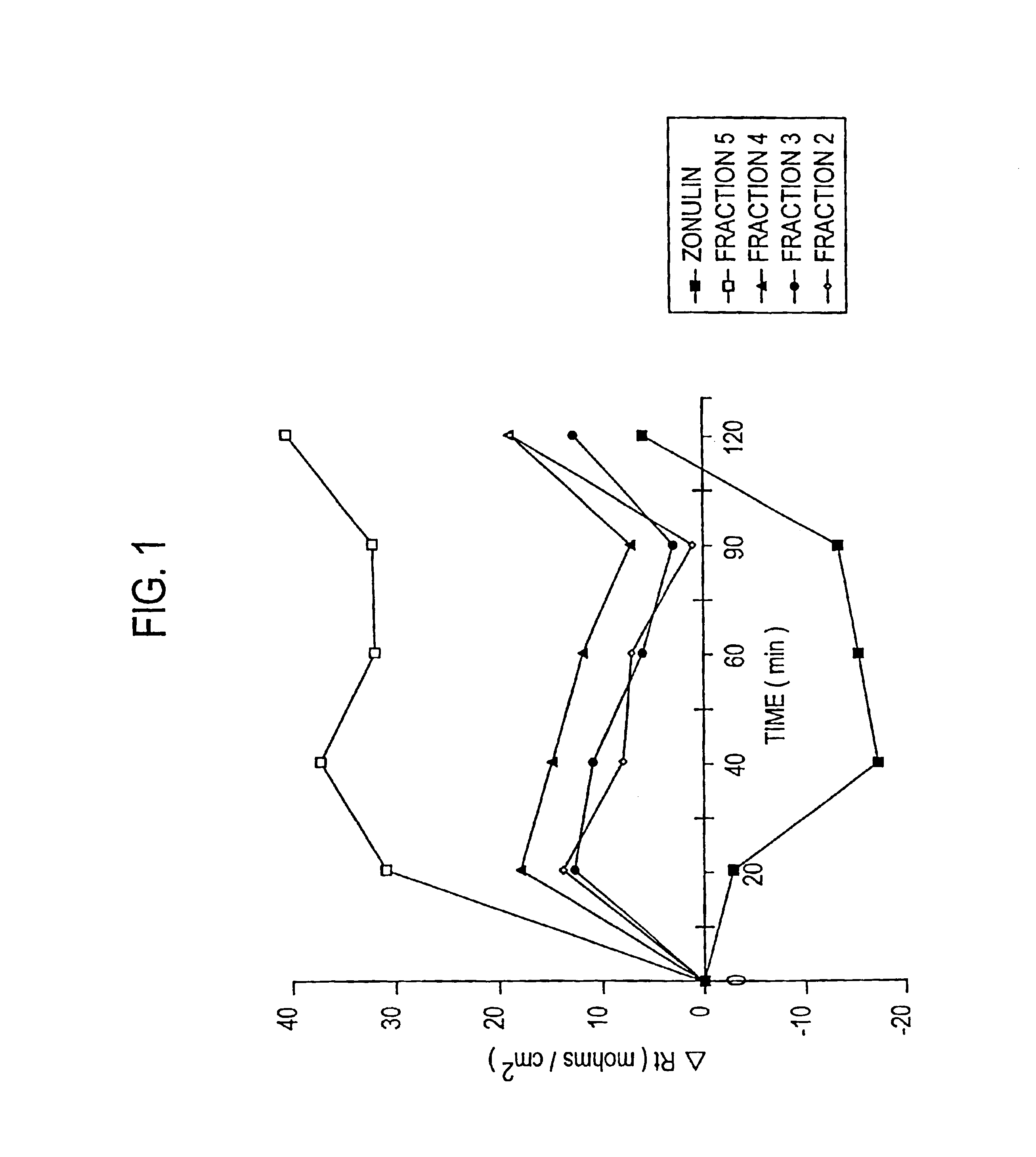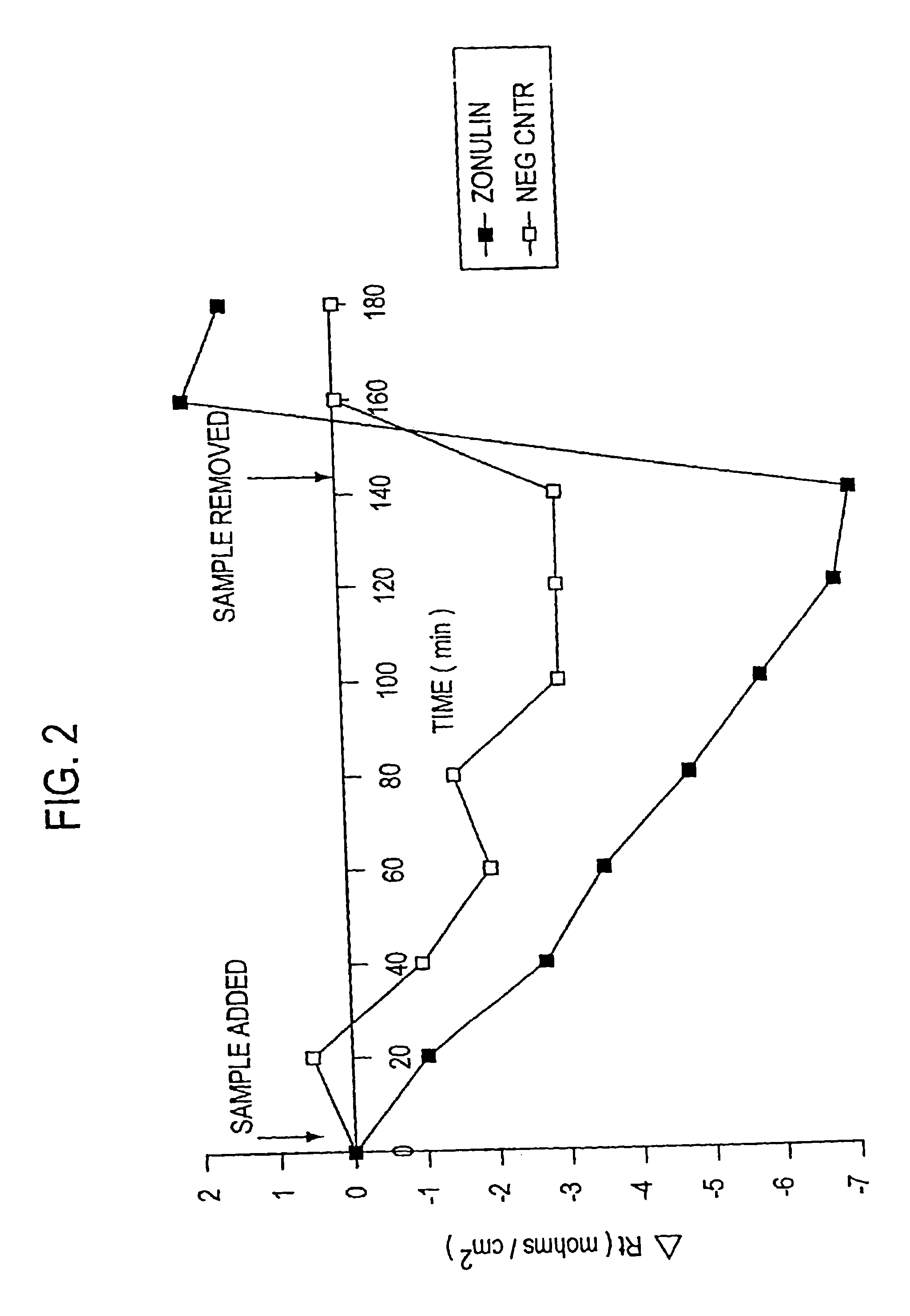Peptide antagonists of zonulin and methods for use of the same
a technology of zonulin and zonulin peptide, which is applied in the field of zonulin peptide antagonists, can solve the problems of not fully understanding the regulation mechanisms that underlie this adaptation and cannot function to physiologically modulate, and achieve the effect of inhibiting the breakdown of the blood brain barrier
- Summary
- Abstract
- Description
- Claims
- Application Information
AI Technical Summary
Benefits of technology
Problems solved by technology
Method used
Image
Examples
example 1
Purification of ZOT
[0052]5000 ml of the supernatant fraction obtained after culturing V. cholerae strain CVD110 (Michalski et al, Infect. Immun., G1:4462-4468 (1993), which had been transformed with plasmid pZ14, was concentrated 1000-fold using a lamina flow filter with a MW cutoff of 10 kDa. The construction of pZ14, which contains the Vibrio cholera zot gene, is described in detail in, inter alia, WO 96 / 37196. The resulting supernatant was then subjected to 8.0% (w / v) SDS-PAGE. Protein bands were detected by Coomassie blue staining of the SDS-PAGE gel. No protein band corresponding to ZOT was detectable when compared to control supernatant from strain CVD110 transformed with plasmid pTTQ181 (Amersham, Arlington Heights, Ill.), and treated in the same manner. Therefore, even though the zot gene was placed behind the highly inducible and strong tac promoter in pZ14, the level of the protein in 1000-fold concentrated pZ14 supernatant was still not detectable by the Coomassie stained...
example 2
Production of Affinity-Purified Anti-ZOT Antibodies
[0063]To obtain specific antiserum, a chimeric glutathione S-transferase (GST)-ZOT protein was expressed and purified.
[0064]More specifically, oligonucleotide primers were used to amplify the zot orf by polymerase chain reaction (PCR) using plasmid pBB241 (Baudry et al, supra) as template DNA. The forward primer (TCATCACGGC GCGCCAGG, SEQ ID NO:25) corresponded to nucleotides 15-32 of zot orf, and the reverse primer (GGAGGTCTAG AATCTGCCCG AT, SEQ ID NO:26) corresponded to the 5′ end of ctxA orf. Therefore, amino acids 1-5 of ZOT were missing in the resulting fusion protein. The amplification product was inserted into the polylinker (SmaI site) located at the end of the GST gene in pGEX-2T (Pharmacia, Milwaukee, Wis.). pGEX-2T is a fusion-protein expression vector that expresses a cloned gene as a fusion protein with GST of Schistosoma japonicum. The fusion gene is under the control of the tac promoter. Upon induction with IPTG, derep...
example 3
Purification of Zonulin
[0071]Based upon the observation in U.S. patent application Ser. No. 08 / 803,364, filed Feb. 20, 1997, that ZOT interacts with a specific epithelial surface receptor, with subsequent activation of a complex intracellular cascade of events that regulate tj permeability, it was postulated in the present invention that ZOT may mimic the effect of a physiological modulator of mammalian tj. It was postulated in U.S. patent application Ser. No. 08 / 859,931, filed May 21, 1997, that ZOT, and its physiological analog (zonulin), would be functionally and immunologically related. Therefore, as described therein, affinity-purified anti-ZOT antibodies and the Ussing chamber assay were used in combination to search for zonulin in various rabbit and human tissues.
[0072]A. Rabbit Tissues
[0073]Initially, zonulin was purified from rabbit intestine. The tissue was disrupted by homogenization in PBS. The resulting cell preparations were than centrifuged at 40,000 rpm for 30 min, t...
PUM
| Property | Measurement | Unit |
|---|---|---|
| pH | aaaaa | aaaaa |
| pH | aaaaa | aaaaa |
| volumes | aaaaa | aaaaa |
Abstract
Description
Claims
Application Information
 Login to View More
Login to View More - R&D
- Intellectual Property
- Life Sciences
- Materials
- Tech Scout
- Unparalleled Data Quality
- Higher Quality Content
- 60% Fewer Hallucinations
Browse by: Latest US Patents, China's latest patents, Technical Efficacy Thesaurus, Application Domain, Technology Topic, Popular Technical Reports.
© 2025 PatSnap. All rights reserved.Legal|Privacy policy|Modern Slavery Act Transparency Statement|Sitemap|About US| Contact US: help@patsnap.com



